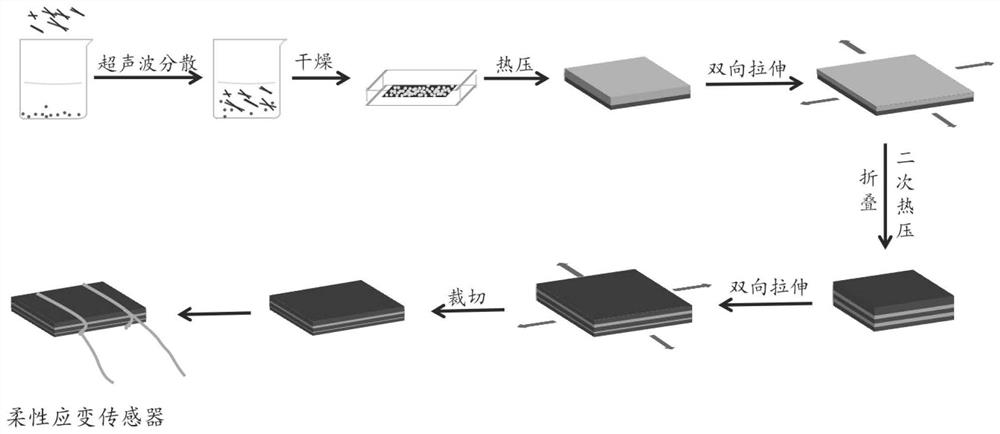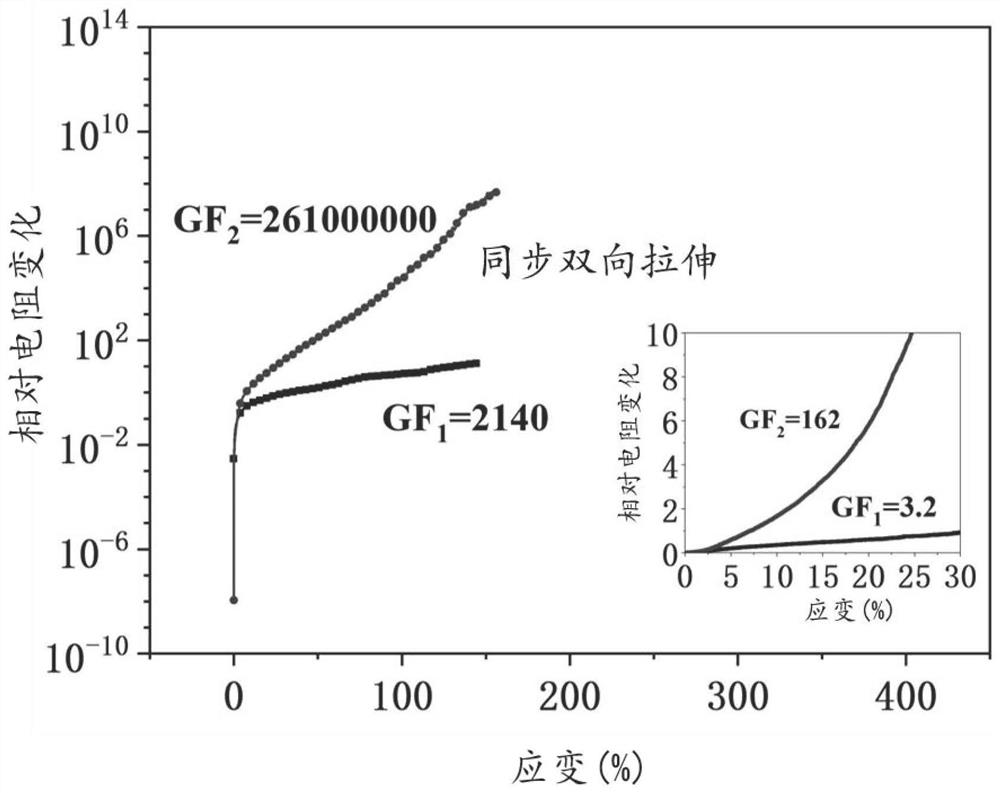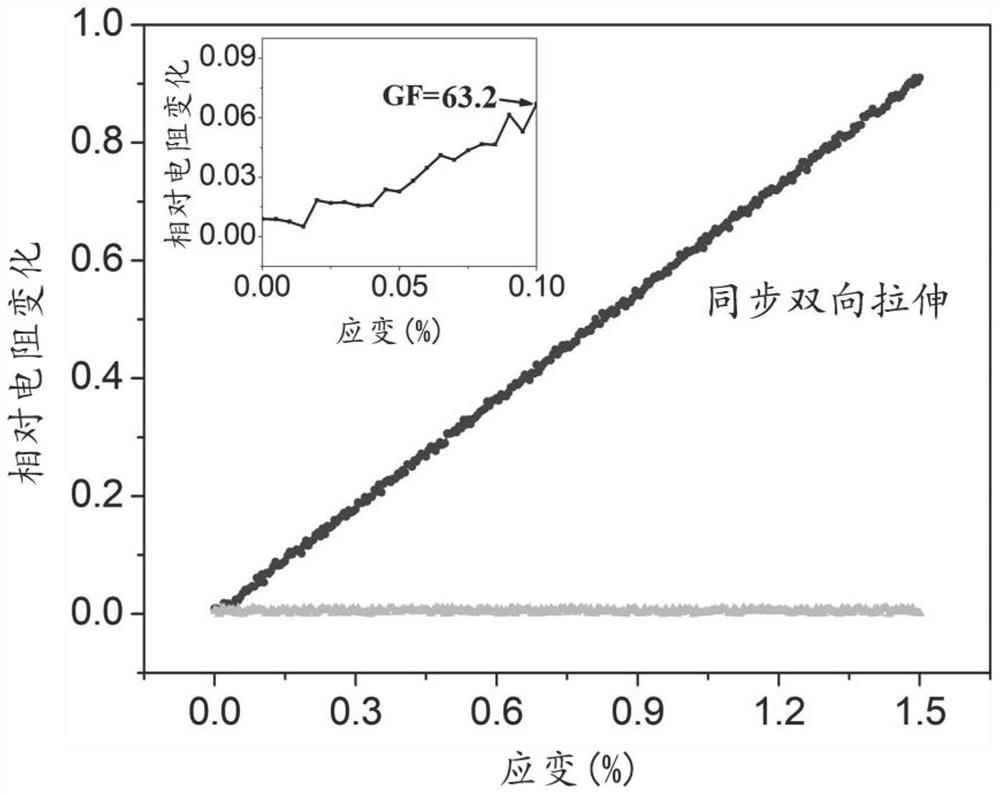A method for preparing flexible strain sensors using biaxial stretching technology
A strain sensor and biaxial stretching technology, applied in the field of sensors, can solve the problems of dispersion of conductive active nanomaterials, easy re-agglomeration plane orientation, etc., achieve large strain range, solve the problems of dispersion and re-agglomeration, and high sensitivity
- Summary
- Abstract
- Description
- Claims
- Application Information
AI Technical Summary
Problems solved by technology
Method used
Image
Examples
Embodiment 1
[0030] like figure 1 As shown, the present invention utilizes biaxial stretching technology to prepare high-performance flexible strain sensor, comprises the following steps:
[0031] Step S1: Disperse the mixture of 0.12 g of reduced graphene oxide and 0.28 g of multi-walled carbon nanotubes in 200 mL of N,N-dimethylformamide solvent for ultrasonic dispersion for 1 hour, and prepare the prepared nanocomposite The solution is poured into a mould, the size of which is 100×100×15 mm, and then the mold is moved into an oven at 80° C. to dry for 24 hours. After drying, a nano-filler composite film is obtained, and the side length of the composite film is 100 mm.
[0032] Step S2: Then spread 10g of polyurethane powder evenly on the composite film, and use a flat vulcanizer to heat press the composite film covered with polyurethane powder for 15 minutes at a temperature of 100°C and a working pressure of 10 MPa to obtain nano Composite sheet.
[0033] Step S3: Move the nanocompos...
Embodiment 2
[0037] The present invention utilizes biaxial stretching technology to prepare high-performance flexible strain sensor, comprises the following steps:
[0038] Step S1: Disperse the mixture of 0.12 g of reduced graphene oxide and 0.28 g of multi-walled carbon nanotubes in 200 mL of N,N-dimethylformamide solvent for ultrasonic dispersion for 1 hour, and prepare the prepared nanocomposite Pour the solution into a mold with a size of 100×100×15mm, and then move the mold into an oven at 80°C to dry for 24 hours. After drying, a nano-filler composite film is obtained, and the side length of the composite film is 100mm;
[0039] Step S2: Then spread 10g of polyurethane powder evenly on the composite film, and use a flat vulcanizer to heat press the composite film covered with polyurethane powder for 15 minutes at a temperature of 100°C and a working pressure of 10 MPa to obtain nano Composite sheets;
[0040]Step S3: Move the nanocomposite sheet into a biaxial tensile testing machi...
Embodiment 3
[0044] The present invention utilizes biaxial stretching technology to prepare high-performance flexible strain sensor, comprises the following steps:
[0045] Step S1: Disperse the mixture of 0.12 g of reduced graphene oxide and 0.28 g of multi-walled carbon nanotubes in 200 mL of N,N-dimethylformamide solvent for ultrasonic dispersion for 1 hour, and prepare the prepared nanocomposite Pour the solution into a mold with a size of 100×100×15mm, and then move the mold into an oven at 80°C to dry for 24 hours. After drying, a nano-filler composite film is obtained, and the side length of the composite film is 100mm;
[0046] Step S2: Then spread 10g of polyurethane powder evenly on the composite film, and use a flat vulcanizer to heat press the composite film covered with polyurethane powder for 15 minutes at a temperature of 100°C and a working pressure of 10 MPa to obtain nano Composite sheets;
[0047] Step S3: Move the nanocomposite sheet into a biaxial tensile testing mach...
PUM
| Property | Measurement | Unit |
|---|---|---|
| length | aaaaa | aaaaa |
Abstract
Description
Claims
Application Information
 Login to View More
Login to View More - R&D
- Intellectual Property
- Life Sciences
- Materials
- Tech Scout
- Unparalleled Data Quality
- Higher Quality Content
- 60% Fewer Hallucinations
Browse by: Latest US Patents, China's latest patents, Technical Efficacy Thesaurus, Application Domain, Technology Topic, Popular Technical Reports.
© 2025 PatSnap. All rights reserved.Legal|Privacy policy|Modern Slavery Act Transparency Statement|Sitemap|About US| Contact US: help@patsnap.com



